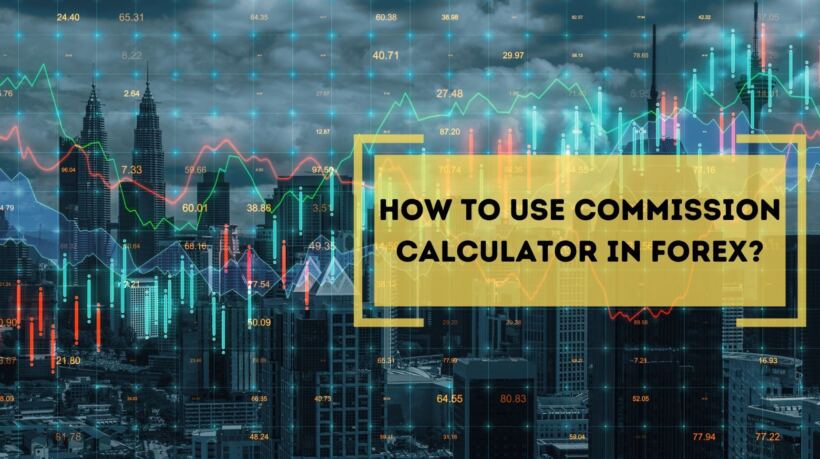Introduction
Forex trading needs to be done with many calculations, some being very basic while others too complex to be carried out manually. Placing trades and making profits won’t be successful unless you learn to make calculated moves. But another important aspect of trading that needs to be calculated in advance is the cost of trading.
Trading does not only cost the capital you are risking but also involves other costs in the form of spreads and commission charged by your forex broker for the services they offer. Calculating the commission on each trade can be confusing for novice traders. But, with the help of a commission calculator forex traders can get fast and accurate results. Let’s find out more about this calculator and how to use it aptly
How is the Forex Commission calculated?
Before we get into the commission calculator forex, you need to understand how forex commission is calculated. Mostly all brokers specify the commission charged on every lot that’s traded. Usually, it’s the standard lot that consists of 100k units of currency. Different brokers mention commission rates differently. While some mention the per-side charges, others mention the round trip. Per side would mean that for every trade, the commission will be charged twice, that is, upon entering and exiting the position. In the case of a round trip, the commission charged for not opening and closing the position will be added together.
In any case, the commission would vary based on your position size, chosen currency pair, and the trading account’s base currency with which you are trading. So, these are the data that you need to feed into the commission calculator forex to get accurate results. Some brokers also charge a volume-based commission, which will vary based on the trade volume each time. This can make the calculation even more confusing than fixed commission charges. Because fixed commissions are way easier to calculate in most cases.
How is the CFD Commission calculated?
CFDs are the short form for Contracts for Difference. CFD trading is quite popular and commonly offered by many forex brokers. Usually forex brokers do offer CFDs on stocks, commodities, indices and cryptocurrencies allowing the traders to diversify their portfolio by trading other markets besides forex. This is a derivative trading instrument as CFDs get their value from the underlying asset’s value. You won’t be trading with the ownership of the actual assets but will only take benefit of the price changes happening for the asset class.
The commission on other CFDs listed as trading instruments is also calculated using a similar method. The calculation process is the same as it is still calculated per lot, taking the standard lot size. The calculation needs to consider the account base currency, number of lots, and the asset class chosen as trading instruments. CFD commission can also be calculated with an online forex commission calculator offered by your broker.They will let you calculate the commission for all trading instruments they offer on the platform. Hence, you can enter the required data into this automated commission calculator, which will immediately return the results with at most precision and speed.
How is the Management fee calculated?
The management fee or the interest is charged to meet the cost of managing a trade position kept overnight. Only scalpers and day traders would be closing their trade positions within a short day. Scalpers usually enter and exit multiple trades within seconds or minutes, and day traders will close their trade positions before the day ends. Hence, they won’t keep any trade position open overnight.
But swing and positional traders will keep the trade position for a longer duration, lasting from a few days to a few weeks or several months. In that case, keeping the trade position running for the required duration will incur some costs for the broker. This cost is referred to as a management fee or interest fee. This is also known as swap rates and rollover fees. The interest rate differences between currencies is the basis for swap rates or management fee charged on a particular trade.
The calculation results can be both positive and negative based on the type of position opened by the trader. A long position will result in a long swap which has to be paid by the trader to the broker. The broker usually deducts this from the account balance automatically. In the case of short positions, it results in a short swap which the broker pays to the trader.
In the case of a long swap, a trader pays and in the case of a short swap a trader earns. Another way to make profits from swap rate differences is the carry trading strategy. In this case, you will be buying a currency with a high-interest rate and selling another currency with a low-interest rate. This way, you can profit from the interest rate differences between the two currencies.
You can use an online swap calculator provided by your broker to calculate the management fee or swap for a trade position. You just need to enter the trade duration as the number of days for which the position will be kept open, along with the chosen currency pair, account base currency and lot size. Then the calculator will return the results for both long swap and short swap within no time.
How to calculate your profit or loss?
Calculating the potential profits and losses that can happen after a trade is a key step in planning and calculating your trades. Getting desired trading results won’t be possible unless you calculate the possible outcome of a trade before entering it into a live account. There is a forex calculator available that you can use to quickly calculate the profits you’ve made in a certain trade. If you are maintaining a trading journal, then it’s better to add accurate results in it, and for that, a profit calculator can be of great use.
Using a profit calculator is a breeze, as you just need to enter details like account base currency, the trading instrument chosen, the type of position you will be opening (long or short), the entry and exit prices for the trade, and the trade size in lots. Then, the calculator will tell you the expected profit and loss in your account base currency. Here, a positive value indicates profits and a negative value indicates losses.
To conclude, commission calculators are a basic yet essential tool every trader needs to use to track trading costs. This tool is easy to use and adds higher efficiency and speed to calculating commissions for every trade. The same thing also applies to the other automated calculators we mentioned above. Making sound trading decisions will always become more accessible with the right trading tools in your toolkit. As a forex trader, you need to use such free trading tools, as the results can help a lot in choosing the best course of action while trading.







